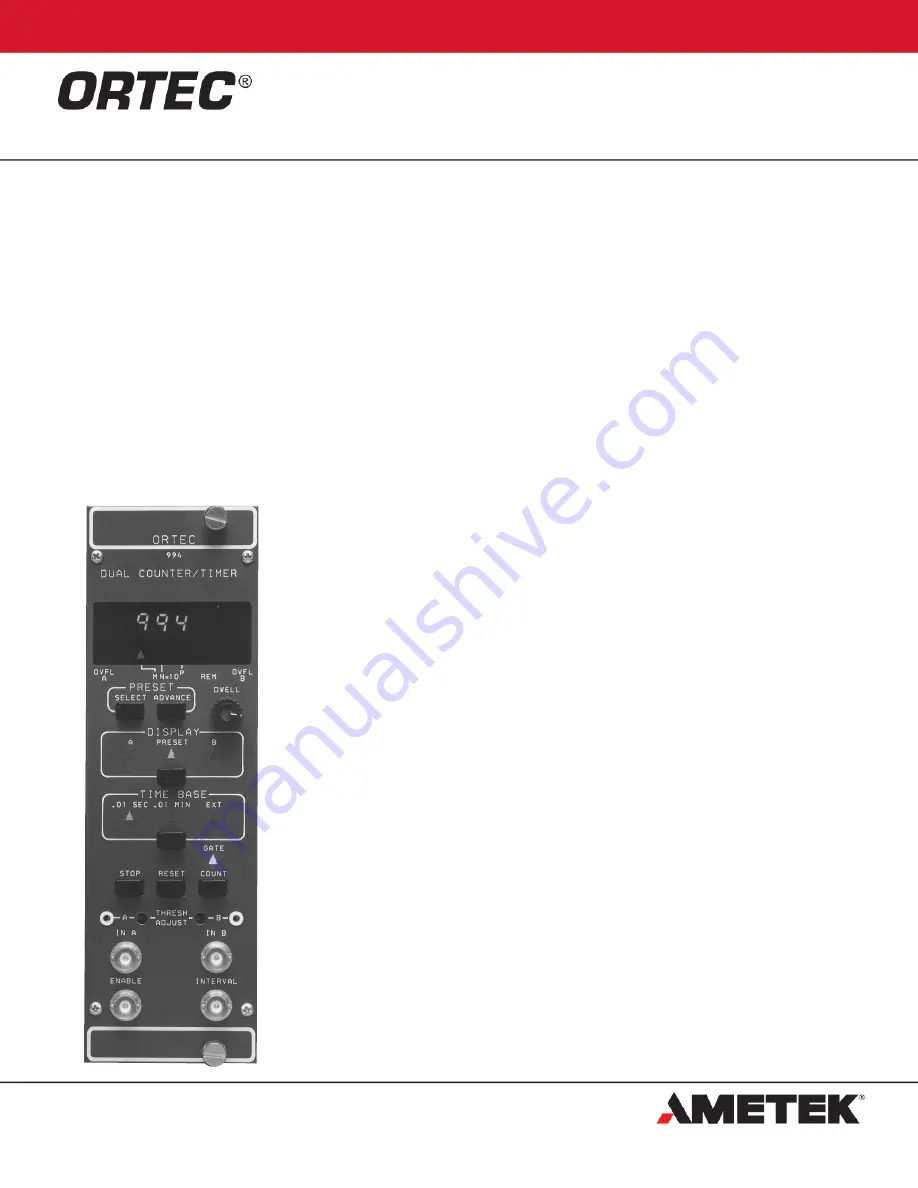
994
Dual Counter and Timer
•Two 8-decade counters and a timer with the
configuration flexibility to serve a variety of
measurement needs
•RS-232-C option provides CCNIM capability
with full computer control and readout
•Can directly drive printers having RS-232-C
ports
•An 8-decade LED display provides
instantaneous readout of the entire counter
capacity, even in dimly lighted rooms
•All commonly used controls are easily
accessible on the front panel
•100-MHz counting rate capability
•Preset time or counts set with the precision of
a two-digit and decade selection
•All options are field-installable
The ORTEC Model 994 Dual Counter and Timer
incorporates two eight-decade counters and a
blind preset timer. Considerable functional
flexibility is designed into the instrument, allowing
it to be configured for a variety of measurement
tasks. Typically, it can be used as two counters
recording separate events under the control of the
preset blind timer. When continuous readout of the
time is needed, Counter A can be diverted to count
the time while Counter B records external events.
This provides the function of a counter and a
displayed preset timer. In some applications, the
time taken to count a preset number of events
must be measured. For this application, Counter
A, coupled with the preset blind counter, can be
used as a preset counter while Counter B records
the time in 0.01-second intervals. In
measurements where it is important to correct for
the dead time of the detector and its associated
electronics, the Gate A input can be switched to
also gate the time clock On and Off with a 100-ns
time resolution. A positive logic signal that defines
the system live time is connected to the Gate A
input. This configuration provides a live-time clock
(Counter A) and a counter (B).
Excellent flexibility in setting the preset value is
offered by the MN X 10
P
selection. The M and N
values provide two-digit precision, while P selects
the decade. Presets can be chosen in the ranges
of 0.01 to 990,000 seconds, 0.01 to 990,000
minutes, or 1 to 99,000,000 counts.
The basic Model 994 includes an 8-decade LED
display that offers instantaneous visual readout of
the full contents of Counter A or B, even in a dimly
lighted room. By adding field-installable options,
considerably enhanced readout and control
capabilities can be incorporated.
The full power of CCNIM (Computer-Controlled
NIM) can be obtained by adding the RS-232-C
option. This plug-in board allows computer control
of all functions normally selectable from the front
panel, including start and stop count, readout,
reset, setting the preset value, selecting the
displayed counter, and selecting the desired time
base. To eliminate accidental operator
interference, the computer can disable all front-
panel controls in the Remote mode. Computer
readout with the CCNIM option includes A and B
counts, the preset value, and which counter is
being displayed. The CCNIM option can directly
drive printers having RS-232-C ports.
The inputs to Counters A and B are individually
selectable as either positive or negative sensing
inputs by changing the Input Polarity Jumpers on
the counter printed wiring board (PWB). The
negative input mode is designed to accept NIM-
standard, fast-negative logic pulses with a fixed
threshold of –250 mV on a 50-
input impedance.
The negative inputs can handle counting rates up
to 100 MHz. The positive input mode can accept
counting rates up to 25 MHz on a 1000-
input
impedance. To enhance the flexibility of the
positive input mode, precision discriminators are
included on both counters. The discriminator
thresholds are variable over the range from
+100 mV to +9.5 V using front-panel, 25-turn
trimpots. The thresholds can be adjusted to suit
the amplitude of a specific source of logic pulses
or used as precision integral discriminators on
analog pulses. For the latter application, the TTL
logic outputs of the discriminators are provided as
test points on the front panel. These outputs can
be used to trigger an oscilloscope while viewing
the analog signal at the counter input on the
oscilloscope. The oscilloscope trace will show the
signals that are being counted by the Model 994,
thus permitting a very selective adjustment of the
threshold.
All the commonly used functions are conveniently
accessible on the front panel. Manual control of
the Count, Stop, and Reset functions is via three
push-buttons. The Gate LED is illuminated when
the Model 994 is enabled to count. Selection of
the 0.01 second, 0.01 minute, or external time
base is made by the Time Base push-button. In
the external mode, the preset counter counts the
events at the counter A input. The Display push-
button switches the display to show the contents
of Counter A, the preset stop value, or the
contents of Counter B. To change the preset
value, the Preset mode must first be selected with
the Display push-button. Subsequently, the Preset
Select push-button is used to choose M, N, or P
for adjustment. Changing the value of M, N, or P is
accomplished with the Preset Advance push-
button. The display contains LED flags to indicate
whether M, N, or P has been selected, to warn
when overflows have occurred in Counter A or
Counter B, and to advise when the front-panel
controls are disabled by the computer in the
Remote mode. When the Model 994 is used in the
automatic recycle mode, the Dwell knob adjusts
the dwell time of the display from 1 to 10 seconds.




